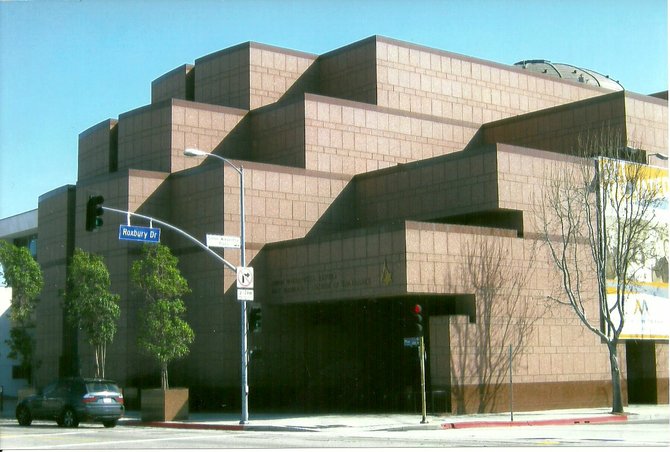 Facebook
Facebook
 X
X
 Instagram
Instagram
 TikTok
TikTok
 Youtube
Youtube

Having lived in Los Angeles during the Rodney King riots of 1992, I’ve always viewed the Museum of Tolerance as a beacon of hope. Located at the corner of Pico and Roxbury Drive in West L.A., the MOT has welcomed four million visitors since 1993.
I visited there recently, arriving just in time to hear Holocaust survivor William Harvey tell his amazing, harrowing story. Born in 1924 in the Czech Republic, Harvey’s graduation in 1943 was quickly followed by deportation to Auschwitz on a 4-day cattle car ride. He was later transferred to Buchenwald and freed when the Americans liberated the death camp in April 1945. From his descriptions, it was obvious that the dead bodies and living skeletons he encountered still haunted him. Harvey went on to build a successful life as a cosmetologist in Beverly Hills.
Although still stung that “all the good men stayed silent,” Harvey is adamant that he does not dwell on the pain of the past “or it will destroy you.” He added, “When you cry, you cry alone – when you smile, the whole world smiles with you.”
Entering the Tolerance Center wing, focused on giving historical context to patterns of intolerance and discrimination, you’re invited to choose between doors labeled “Prejudiced” and “Unprejudiced.” The struggle for civil rights in the U.S. is highlighted. Scores of video screens flash 40-year-old newsreels of civil rights marches and Klan rallies. They’ve added an exhibit since my last visit that looks at the intolerance that sparked 9/11 and the terrorism of jihad.
The Holocaust Museum is the centerpiece of the MOT and the most involving, disturbing exhibit. Developments leading up to the rise of fascism and Nazi power in Germany are traced through individual stories as well as historical facts. The complicitness of ordinary citizens is noted. You’re given a passport for an actual individual affected by the Holocaust. You then pass through a hall that chronicles the events and environment of Germany from 1920 to the defeat of Nazi Germany. By the end of the exhibit you discover whether your victim survived. Mine, a seven-year-old boy, did not.
Another Holocaust victim spoke that afternoon. Most are in their 80’s now, so the day will come soon when they are all gone. We will rely on recordings of their testimonies. In the meantime they’re eager to get their story out so the world will not forget – so that in the future, if a similar situation arises, all the good men will not stay silent. You emerge from the MOT not only with a greater understanding of the events that led to the Holocaust, but with an experience that induces self-reflection and can truly alter how you see the world.


Having lived in Los Angeles during the Rodney King riots of 1992, I’ve always viewed the Museum of Tolerance as a beacon of hope. Located at the corner of Pico and Roxbury Drive in West L.A., the MOT has welcomed four million visitors since 1993.
I visited there recently, arriving just in time to hear Holocaust survivor William Harvey tell his amazing, harrowing story. Born in 1924 in the Czech Republic, Harvey’s graduation in 1943 was quickly followed by deportation to Auschwitz on a 4-day cattle car ride. He was later transferred to Buchenwald and freed when the Americans liberated the death camp in April 1945. From his descriptions, it was obvious that the dead bodies and living skeletons he encountered still haunted him. Harvey went on to build a successful life as a cosmetologist in Beverly Hills.
Although still stung that “all the good men stayed silent,” Harvey is adamant that he does not dwell on the pain of the past “or it will destroy you.” He added, “When you cry, you cry alone – when you smile, the whole world smiles with you.”
Entering the Tolerance Center wing, focused on giving historical context to patterns of intolerance and discrimination, you’re invited to choose between doors labeled “Prejudiced” and “Unprejudiced.” The struggle for civil rights in the U.S. is highlighted. Scores of video screens flash 40-year-old newsreels of civil rights marches and Klan rallies. They’ve added an exhibit since my last visit that looks at the intolerance that sparked 9/11 and the terrorism of jihad.
The Holocaust Museum is the centerpiece of the MOT and the most involving, disturbing exhibit. Developments leading up to the rise of fascism and Nazi power in Germany are traced through individual stories as well as historical facts. The complicitness of ordinary citizens is noted. You’re given a passport for an actual individual affected by the Holocaust. You then pass through a hall that chronicles the events and environment of Germany from 1920 to the defeat of Nazi Germany. By the end of the exhibit you discover whether your victim survived. Mine, a seven-year-old boy, did not.
Another Holocaust victim spoke that afternoon. Most are in their 80’s now, so the day will come soon when they are all gone. We will rely on recordings of their testimonies. In the meantime they’re eager to get their story out so the world will not forget – so that in the future, if a similar situation arises, all the good men will not stay silent. You emerge from the MOT not only with a greater understanding of the events that led to the Holocaust, but with an experience that induces self-reflection and can truly alter how you see the world.
Comments